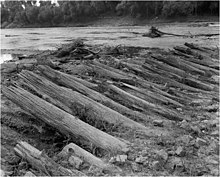Bailey's Dam
| Bailey's Dam | |
|---|---|
 Remnants of Bailey's Dam in 1984 | |
| Location | Alexandria / Pineville, Louisiana |
| Construction began | April 28, 1864 |
| Opening date | May 8, 1864 |
| Demolition date | May 13, 1864 |
| Dam and spillways | |
| Type of dam | Rock-crib |
| Impounds | Red River |
| Height | ~7 ft. |
| Length | ~758 ft. |
Bailey's Dam Site | |
| Location | Red River S of U.S. 71, Alexandria, Louisiana |
| Coordinates | 31°19′32″N 92°27′7″W / 31.32556°N 92.45194°W |
| Area | 8 acres (3.2 ha) |
| Built | 1864 |
| NRHP reference No. | 76000973[1] |
| Added to NRHP | June 29, 1976 |
Bailey's Dam was a
Background
The Red River was an important transportation corridor through Louisiana, where the river channel meandered through alluvium. A short distance upstream of Alexandria, the river crosses two ledges of sandstone and siltstone. The depth of water over these bedrock ledges was less than the channel depth through nearby alluvium, and the downstream ledge controlled the water level upstream of that ledge.[4]
During the Red River Campaign in March 1864, General
Construction

Construction soon began supervised by Bailey. Around 3,000 soldiers started to fell trees and bring rock, brick, stone and other materials to the construction site. As construction progressed, two wings of the dam developed from either shore of the 758-foot-wide (231 m) river. The dam was at the bottom of the downstream ledge and was built with local materials. Where trees were plentiful on the left (east) side of the river, men with
Among the materials used were that of the Red River Railroad.
Historical significance

By May 6, the dam had raised the river level to four feet and by May 8, it was over five feet, allowing some of the smaller boats to pass in directly behind the dam. At 5:30 AM on May 9, two of the barges surprisingly broke loose, sending a gush of water downstream. Only four of Porter's ships including the
Modern day

Bailey's Dam Site was listed in the
References
- ^ "National Register Information System". National Register of Historic Places. National Park Service. March 13, 2009.
- ^ a b c "Bailey's Dam: How to float gunboats in three feet of water". Civil War Preservation Trust. Archived from the original on 9 April 2016. Retrieved 24 July 2010.
- ^ a b "The Red River Campaign" (PDF). National Park Service. Retrieved 3 August 2010.
- ^ a b "Bailey's Dam" (PDF). Louisiana Department of Culture, Recreation & Tourism. Retrieved 7 June 2019.
- ^ "Red River Campaign begins". HISTORY. Retrieved 2022-11-30.
- ^ "Causes and consequences of nineteenth century droughts in North America".
- ^ Smith, Steven D.; George J. Castille III (March 1986). "Bailey's Dam – Advance". Department of Culture, Recreation and Tourism. Archived from the original on 2011-06-09. Retrieved 24 July 2010.
- ^ "United States Colored Troops, 97th Regiment, United States Colored Infantry". National Park Service. Retrieved 7 June 2019.
- ^ "United States Colored Troops, 99th Regiment, United States Colored Infantry". National Park Service. Retrieved 7 June 2019.
- ^ Smith, Steven D.; George J. Castille III (March 1986). "Bailey's Dam – Dam". Department of Culture, Recreation and Tourism. Archived from the original on 2011-06-09. Retrieved 24 July 2010.
- ^ Smith, Steven D.; George J. Castille III (March 1986). "Bailey's Dam – Works". Department of Culture, Recreation and Tourism. Archived from the original on 2011-06-09. Retrieved 24 July 2010.
- ^ a b "The Flag of the United States of America The Red River Campaign (April ~ May, 1864)". The Emblem of the Louisiana State Militia Louisiana's Military Heritage:Battles, Campaigns, and Maneuvers. USS KIDD. Archived from the original on 2010-11-29. Retrieved 24 July 2010.
- ^ "John Overton Lock And Dam, west Louisiana". Find Lakes. Retrieved 24 July 2010.
- ^ Smith, Steven D.; George J. Castille III (March 1986). "Bailey's Dam – Introduction". Department of Culture, Recreation and Tourism. Archived from the original on 9 June 2011. Retrieved 24 July 2010.
External links
- Bailey's Dam – Louisiana Department of Culture, Recreation and Tourism
- Bailey's Dam – Civil War Preservation Trust Archived 2016-04-09 at the Wayback Machine
- Historic American Engineering Record (HAER) No. LA-6, "Bailey's Dam, Red River, Alexandria, Rapides Parish, LA", 21 photos, 12 data pages, 2 photo caption pages


